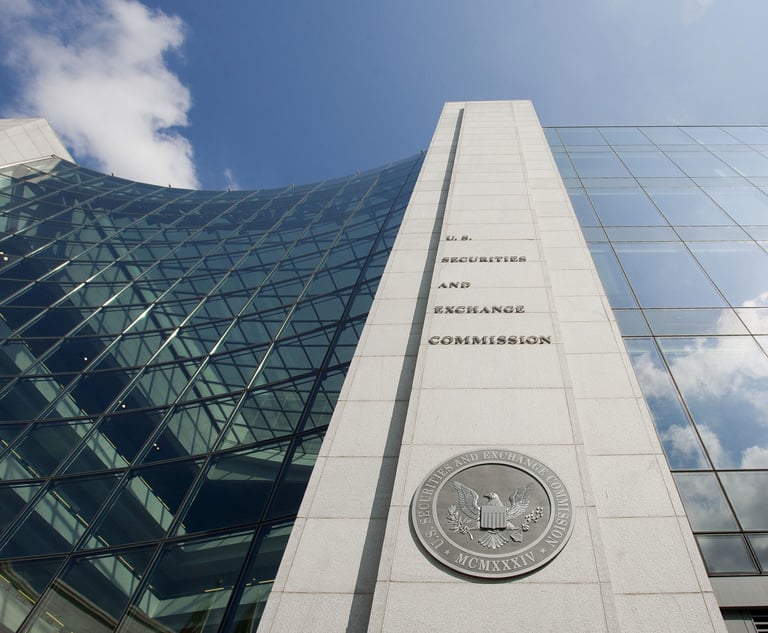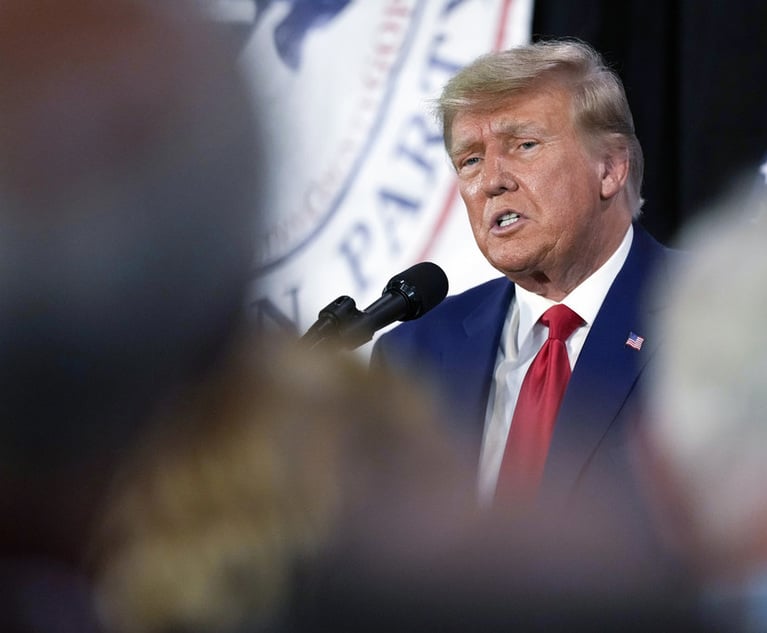Supreme Court <i>Gabelli</i> decision will continue to bring changes to SEC enforcement policy
For companies concerned about possible SEC enforcement proceedings related to the 2007-2009 financial credit crisis, the Gabelli decision makes clear just how long they need to hold their breath.
February 26, 2014 at 03:00 AM
4 minute read
The original version of this story was published on Law.com
The new leadership team at the U.S. Securities & Exchange Commission (SEC) has pledged to bring about positive change to the way it approaches its important regulatory enforcement duties. It remains to be seen in exactly what form this change will take. Some of the most significant changes to the way the SEC approaches its work, however, are likely to come from the outside — specifically, as a result of what has been described as the “mildly technical decision” issued in February 2013 by the U.S. Supreme Court in Gabelli v. Securities & Exchange Commission.
The case began in 2008, when the SEC sued a mutual fund investment advisor, Gabelli Funds LLC, in New York federal district court for alleged violations of the Investment Advisors Act of 1940. According the SEC, between 1999 and 2002, senior officers at Gabelli aided and abetted an important client in fraudulent “market timing” activity that allowed the client to profit from differences in the closing times for U.S. and foreign financial exchanges. Among other things, the SEC sought to impose civil monetary penalties against Gabelli. Gabelli moved to dismiss, arguing, in part, that the claim for civil penalties was time-barred by the five-year statute of limitations set out in 28 U.S.C. § 2462. The district court agreed and dismissed that claim.
On appeal to the 2nd Circuit, the SEC argued that it was entitled to the protections afforded by the discovery rule. In the SEC's view, the limitations period on its claims against Gabelli began to run only after the SEC discovered the fraud, not when it occurred. The 2nd Circuit agreed, holding that such fraud-related claims do not accrue until a plaintiff knows or should have known of the fraud.
In a decision authored by Chief Justice John Roberts, the Supreme Court unanimously rejected the 2nd Circuit's holding. According to the Court, under the “most natural reading” of Section 2462, a fraud claim accrues when it occurs and not when the SEC discovers the fraud. Noting that the discovery rule historically has not been applied in civil enforcement proceedings brought by the government, the Court also found fault with the notion that the SEC can or should be equated with a typical plaintiff in a civil case. Rather, the two are distinct, and the Court stressed that there are important reasons for the distinction: “Most of us do not live in a state of constant investigation; absent any reason to think we have been injured, we do not typically spend our days looking for evidence that we were lied to or defrauded. And the law does not require that we do so.”
The “primary mission” of the SEC, on the other hand, is to investigate and “root out” fraud. And it has many legal tools at its disposal to do so, including: demanding that brokers and dealers submit detailed information, even before a suit is filed; offering and paying monetary awards to whistleblowers; and issuing subpoenas for documents and witnesses it deems relevant to an investigation. As Chief Justice Roberts explained, “[c]harged with this mission and armed with these weapons, the SEC as enforcer is a far cry from the defrauded victim the discovery rule evolved to protect,” and does not need protections afforded by that rule.
The Court went on to observe that, even if that were not the case, there is a practical limit on the ability of courts to allow the government to rely on the discovery rule. The federal government is composed of multiple, overlapping bureaucracies staffed by thousands of employees. Consequently, determining what the government knew and when would be an unrealistic, virtually impossible exercise.
The decision is significant and likely to have a lasting impact. Indeed, for those companies who are or were concerned about possible SEC enforcement proceedings related to their conduct during the 2007-2009 financial credit crisis, the Gabelli decision makes clear just how long they need to hold their breath. For the SEC, there is new and powerful pressure for greater vigilance and efficiency in the identification and prosecution of cases. Increased use of tolling agreements with parties under investigation can be expected as well. Finally, given that the Supreme Court's holding in Gabelli was limited to actions in which the SEC seeks a civil monetary penalty, one should look for the SEC to take greater advantage of the many other enforcement remedies available to it, including disgorgement, injunctive relief and suspensions from the industry.
This content has been archived. It is available through our partners, LexisNexis® and Bloomberg Law.
To view this content, please continue to their sites.
Not a Lexis Subscriber?
Subscribe Now
Not a Bloomberg Law Subscriber?
Subscribe Now
NOT FOR REPRINT
© 2025 ALM Global, LLC, All Rights Reserved. Request academic re-use from www.copyright.com. All other uses, submit a request to [email protected]. For more information visit Asset & Logo Licensing.
You Might Like
View All
SEC Penalizes Wells Fargo, LPL Financial $900,000 Each for Inaccurate Trading Data

US Reviewer of Foreign Transactions Sees More Political, Policy Influence, Say Observers

Pre-Internet High Court Ruling Hobbling Efforts to Keep Tech Giants from Using Below-Cost Pricing to Bury Rivals
6 minute read
Preparing for 2025: Anticipated Policy Changes Affecting U.S. Businesses Under the Trump Administration
Trending Stories
- 1You Too Can Be a Programmer: Connecting to Legal Platform APIs With Generative AI (Part 2)
- 2Court of Appeals and Appellate Division As Courts of First Instance
- 3Federal Judge Slaps Down the SEC’s Attempt to Regulate Crypto Liquidity Providers
- 4A Client Is Guilty; But Another Man Is Wrongfully Convicted
- 5Legal Tech's Predictions for Cybersecurity in 2025
Who Got The Work
Michael G. Bongiorno, Andrew Scott Dulberg and Elizabeth E. Driscoll from Wilmer Cutler Pickering Hale and Dorr have stepped in to represent Symbotic Inc., an A.I.-enabled technology platform that focuses on increasing supply chain efficiency, and other defendants in a pending shareholder derivative lawsuit. The case, filed Oct. 2 in Massachusetts District Court by the Brown Law Firm on behalf of Stephen Austen, accuses certain officers and directors of misleading investors in regard to Symbotic's potential for margin growth by failing to disclose that the company was not equipped to timely deploy its systems or manage expenses through project delays. The case, assigned to U.S. District Judge Nathaniel M. Gorton, is 1:24-cv-12522, Austen v. Cohen et al.
Who Got The Work
Edmund Polubinski and Marie Killmond of Davis Polk & Wardwell have entered appearances for data platform software development company MongoDB and other defendants in a pending shareholder derivative lawsuit. The action, filed Oct. 7 in New York Southern District Court by the Brown Law Firm, accuses the company's directors and/or officers of falsely expressing confidence in the company’s restructuring of its sales incentive plan and downplaying the severity of decreases in its upfront commitments. The case is 1:24-cv-07594, Roy v. Ittycheria et al.
Who Got The Work
Amy O. Bruchs and Kurt F. Ellison of Michael Best & Friedrich have entered appearances for Epic Systems Corp. in a pending employment discrimination lawsuit. The suit was filed Sept. 7 in Wisconsin Western District Court by Levine Eisberner LLC and Siri & Glimstad on behalf of a project manager who claims that he was wrongfully terminated after applying for a religious exemption to the defendant's COVID-19 vaccine mandate. The case, assigned to U.S. Magistrate Judge Anita Marie Boor, is 3:24-cv-00630, Secker, Nathan v. Epic Systems Corporation.
Who Got The Work
David X. Sullivan, Thomas J. Finn and Gregory A. Hall from McCarter & English have entered appearances for Sunrun Installation Services in a pending civil rights lawsuit. The complaint was filed Sept. 4 in Connecticut District Court by attorney Robert M. Berke on behalf of former employee George Edward Steins, who was arrested and charged with employing an unregistered home improvement salesperson. The complaint alleges that had Sunrun informed the Connecticut Department of Consumer Protection that the plaintiff's employment had ended in 2017 and that he no longer held Sunrun's home improvement contractor license, he would not have been hit with charges, which were dismissed in May 2024. The case, assigned to U.S. District Judge Jeffrey A. Meyer, is 3:24-cv-01423, Steins v. Sunrun, Inc. et al.
Who Got The Work
Greenberg Traurig shareholder Joshua L. Raskin has entered an appearance for boohoo.com UK Ltd. in a pending patent infringement lawsuit. The suit, filed Sept. 3 in Texas Eastern District Court by Rozier Hardt McDonough on behalf of Alto Dynamics, asserts five patents related to an online shopping platform. The case, assigned to U.S. District Judge Rodney Gilstrap, is 2:24-cv-00719, Alto Dynamics, LLC v. boohoo.com UK Limited.
Featured Firms
Law Offices of Gary Martin Hays & Associates, P.C.
(470) 294-1674
Law Offices of Mark E. Salomone
(857) 444-6468
Smith & Hassler
(713) 739-1250






